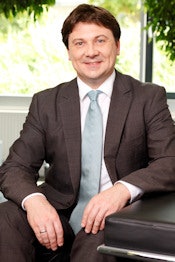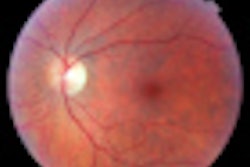
Helium shortages are continuing to challenge MRI manufacturers and raise questions about guaranteed supply for medical purposes. Used widely in party balloons, helium is needed to cool MRI magnets that work at high temperatures due to their superconductivity and high energy current. Globally, the medical sector accounts for only 25% of helium usage, and flat-screen TVs and displays are a key competitor.
The current shortfall does not amount to a long-term catastrophe, according to Tom Rauch, global sourcing manager for service and aftermarket solutions at GE Healthcare in the U.S. "What we've experienced recently is a short-term shortage where demand outstrips immediate supply. It has been a difficult year for helium availability, and this looks like it will continue for the first half of 2013 before anticipated recovery due to new sources of helium coming online."
 Hospitals must monitor cryogen levels closely, according to GE Healthcare's Tom Rauch.
Hospitals must monitor cryogen levels closely, according to GE Healthcare's Tom Rauch.A large second plant is due to open soon in Qatar (known as the Qatar 2 Facility), as well as smaller plants in the U.S. and Algeria, and liquid helium availability should start to improve in the second half of next year. In the meantime, hospitals should follow preventive maintenance schedules and monitor cryogen levels to avoid a "quench" of the magnet -- in other words, a loss of all helium due to running the scanner too hard at low cryogen levels or after a power cut. Such quenches can cause damage and significant scanner downtime, Rauch warned.
In the U.S., helium shortages are posing a severe risk to producers and hospitals, with the result that new legislation has been proposed in the form of the Helium Stewardship Act of 2012. In Europe, some vendors claim that operations have been interrupted due to insufficient helium supply, and one source estimates that lack of helium has contributed to a drop in sales of MR systems by as much as 10% over the past year. Reports are mixed about the extent of interruption to hospital running. Although there does not appear to be any strong move to resort to legislation over helium supply, observers are keeping a sharp eye on the future availability of helium and continue to research alternatives to this resource for MR development.
"Siemens is aware of the global helium shortage. Nonetheless our sales and production are according to plan," said CEO for MR Bernd Ohnesorge from Siemens Healthcare in Germany. "There is an annual shortage during the summer months. The shortage occurs every year and thus can be managed."
 Zero helium boil-off technology, in most cases, means that Siemens Healthcare does not have to add helium to MR systems during normal operations, Bernd Ohnesorge said.
Zero helium boil-off technology, in most cases, means that Siemens Healthcare does not have to add helium to MR systems during normal operations, Bernd Ohnesorge said.With regard to service visits, he noted that Siemens always fills helium to a level that ensures smooth clinical operation at all times. "As we supply our machines with the zero helium boil-off technology, in most cases we do not have to add helium during normal operations at all," he said.
His comments were echoed by Toshiba Medical Systems, whose executives reported that customer hospitals have not so far experienced shortages. Magnet manufacturers, however, have found there hasn't been enough helium supply to fulfill magnet production requirements.
"Lack of helium has impacted new magnet production, which has meant limited offers and consequently slightly reduced availability for customers over the past 12 months," said Alain Bertinatti, MR business unit senior manager at Toshiba Medical Systems in the Netherlands. "The worst period was over last summer, and though the situation is ongoing, the problem looks like it may be easing now."
Shortages have stemmed from a lack of capacity at several helium facilities that underwent heavy maintenance last summer, which in turn decreased availability of liquid helium supply for months in Europe rather than a shortage of liquid helium itself, he noted.
"We didn't experience any shortage of helium in our MR installed base. However the price of helium increased by 10% to 20% due to scarcity," said Bertinatti, adding that it was easy to monitor a system's helium level and anticipate helium needs well before minimum levels occurred, giving helium suppliers more time to provide it. "Hospitals will still have priority for helium supply -- and, to my knowledge, no MR hospital installation has been down due to helium shortages."
GE Healthcare has also struggled to maintain output with customer demand, a situation that started in the third quarter of 2011, Rauch said. The shortages have had an impact on field service too. Systems are being filled with less helium during each service event, requiring a higher frequency of contract visits and more downtime for customers, although the reduction in refill volumes depend on the location and equipment involved, he explained.
While the contract price of liquid helium is around 8 to 9 euros ($10 to $11 U.S.) per liter between MR manufacturers and helium suppliers, the shortages have led to suppliers declaring "force majeure" on most contractual volume commitments, leading to a rise in the spot price of liquid helium to around 20 euros ($26) per liter.
"The pressure is definitely on us now that helium suppliers aren't fulfilling their contractual obligations in terms of helium quantity, and any extra costs incurred through spot purchases of liquid helium are not passed on to our contract customers," Rauch said.
To counter the problems of helium shortage, GE has embarked on a low cryogen magnet design that requires less helium for installation, in conjunction with new superconnecting wire design. The new technology is unlikely to be commercially available before 2015, however. At present, zero boil-off systems require up to 2,000 liters of liquid helium before installation.
Other companies are working on alternative technologies using other superconducting compounds at higher temperature, and they have possible future applications in MRI.
"The minimal boil-off machines we are shipping now will theoretically be in the market for around 15 years and will need servicing for their entire lives," Rauch said. "In addition, there are still older machines in use that are neither zero- nor low boil-off, so there is still a strong service demand from these."
Another strategy to combat helium shortage involves catching helium gas released into the atmosphere during the filling process and selling it back to the helium supplier.
"Of the liquid with which we fill our magnets, we can recover 40% to 50% as gas to sell back to suppliers. Recycling not only saves us money but also saves helium resources for other users in the market," he noted.
For information about the situation in the U.S., click here.



















